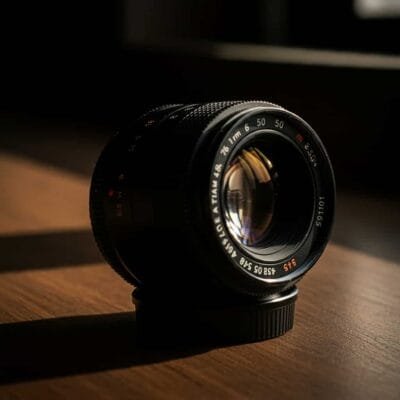
When you start entering into the world of photography, choosing the right camera lens can be very overwhelming. Lenses are like magic tools for your camera. They will change the look of your photographs: through the details shot really close to objects or panoramic views of the landscape. All lenses capture light and depth in different ways, giving you countless creative options. So dive into basics of camera lenses so you feel confident when selecting the right one for your next photo adventure!
- Why Lenses Matter
- Key Features to Consider
- Types of Camera Lenses and When to Use Each One
- Prime vs. Zoom Lenses: Which is Right for You?
- Wide-Angle Lenses: Capturing Landscapes and Architecture
- Telephoto Lenses: Perfect for Wildlife and Sports Photography
- Macro Lenses: Getting Up Close with Detailed Shots
- Portrait Lenses: Choosing the Best Lens for Portrait Photography
- Focal Length Explained: How It Impacts Your Photos
- Aperture and Depth of Field: Key Factors in Lens Selection
- Image Stabilization: Why It Matters When Choosing a Lens
- Lens Compatibility: How to Ensure Your Lens Fits Your Camera
- Budgeting for Lenses: Quality vs. Price Considerations
- Top Tips for Buying Your First Camera Lens
- Choosing the Right Lens for Video: What You Need to Know
- Lens Accessories to Enhance Your Photography Experience
- Common Mistakes to Avoid When Buying a Camera Lens
- FAQs:
Why Lenses Matter
The camera lens can be thought of as the “eye” of your camera. While our eyes may adjust to near or far, the idea behind lenses is basically the same – a camera lens focuses on one particular detail in order to make an image. The type of lens used for a particular shot not only determines how close or far away your subject will appear but also dictates how much of the scene fits into the frame and how fuzzy or clear the background will be.
Key Features to Consider
When you learn about lenses, there are a few important terms that come up: focal length, aperture, and image stabilization. Let’s break these down in simple terms:
- Focal Length : Think of this as your zoom power. Measured in millimeters, the focal length tells you how much of the scene the lens will capture. For example, a short focal length like 18mm takes in a wider view, making it perfect for landscapes. For wildlife or sports, you want a longer focal length, such as 200mm.
- Aperture : This defines the amount of light entering the camera. A large aperture lens (f/1.8) is a good low-light setting lens which brings a blur background effect, making your subject crisp and quite clear. Smaller apertures such as f/11 produce scenes where everything will be in focus.
- Image Stabilization : Ever had a photo come out blurry? Image stabilization helps reduce the shakiness, especially useful when zooming in or shooting in low light without a tripod.
Types of Camera Lenses and When to Use Each One
- Prime Lenses: The lens has a fixed focal length and good image quality, especially in low-light conditions. It is ideal for a portrait shot, street photography, and all else where image quality would be paramount.
- Zoom Lenses: The lens can have varying focal lengths. In short, you can zoom-in and out without changing the lenses; they are quite versatile and could use them for travel, wildlife photography or generalized shooting.
- Wide-Angle Lenses: Wide-angle lenses capture a greater field of view; they are ideal for landscapes, architecture, and interior photography.
- Telephoto Lenses: These lenses help to zoom in on distant subjects and are an ideal means for wildlife, sports, and event photography.
- Macro Lenses: Macro lenses are those that are designed for close-up photography and allow for the capturing of fine details of small objects.
- Portrait Lenses: Since portrait lenses have long focal lengths along with high aperture values, they create pleasing portrait images with shallow DOF.
Prime vs. Zoom Lenses: Which is Right for You?
Choosing between a prime lens and a zoom lens can be quite difficult, but knowing the differences will help you decide which is best suited to your way of style. Both prime and zoom lenses have their strengths and limitations, but actually choosing between the two really depends upon what you find pleasure in capturing and how you like to take pictures.
Prime Lenses: Sharp and Simple
Prime lenses have a fixed focal length, so they cannot zoom in or out. Sounds limiting? Not really. Actually, this gives prime lenses some pretty impressive advantages: basically, image quality and sharpness, especially in portraits and low-light situations. Their wide aperture allows more light in through the camera; therefore, they are ideal for shooting indoors or during sunset. Plus, with an enormous aperture, prime lenses make that beautiful background blur—the known bokeh which really makes your subject pop.
Downside? You would need to move closer or farther to frame your shot because the lens does not zoom. But if you want some clean shots with fantastic depth, a prime lens is your way to go.
Zoom Lenses: Versatile and Convenient
However, zoom lenses are multiple focal lengths in one lens. They can be very flexible for someone who needs to shoot anything from wide shots to close-ups. You can go from a wide shot of an event to the persona by simply twisting this lens. I personally find that zoom lenses are very popular when shooting travel, events, and street photography, where one may want to capture sweeping landscapes as well as tighter portraits of people.
Though zoom lenses may not have the same sharpness as prime lenses, today’s zooms are impressively clear and are a great choice if you prefer having a one-lens solution. Some zoom lenses, like 24-70mm, are known for their balanced mix of wide and zoom capabilities, making them a solid option for a variety of shots.
Recommended Prime Lens: Canon EF 50mm f/1.8 STM Lens
Recommended Zoom Lens: Nikon AF-S DX NIKKOR 18-140mm f/3.5-5.6G
Wide-Angle Lenses: Capturing Landscapes and Architecture
Wide-angle lenses shoot a large field of view. Thus, they are extremely useful while shooting landscapes and architectural shots where you want to take in as much of the scene as possible. These are used in cityscapes and interiors that produce dramatic perspectives.
- Recommended Wide-Angle Lens: Canon EF-S 10-18mm f/4.5-5.6 IS STM Lens
Telephoto Lenses: Perfect for Wildlife and Sports Photography
A telephoto lens is necessary when taking shots from a distance- taking those distant subjects like wildlife or sport action. These lenses bring scenes up close, and you are able to photograph details that would otherwise be out of reach.
- Recommended Telephoto Lens: Tamron 70-300mm f/4.5-6.3 Di III RXD
Macro Lenses: Getting Up Close with Detailed Shots
For capturing close-up images of flowers, insects, or other small subjects up close, a macro lens will be very essential. These lenses truly reveal incredible details and textures that you could never imagine, because you get so close to the subject.
- Recommended Macro Lens: Canon RF 35mm F1.8 IS Macro STM Lens
Portrait Lenses: Choosing the Best Lens for Portrait Photography
Portrait lenses are usually between 50 and 85mm, so you’d want something in a wide aperture at either f/1.8 or f/2.8 in order to blur the background. These lenses are always pretty great for professional headshots or family portraits.
- Recommended Portrait Lens: Sony 85mm F1.8 Lens
Focal Length Explained: How It Impacts Your Photos
Focal length determines how close to or far from you your subject will appear and impacts the angle of view in the scene. A shorter focal length captures a wider angle, such as 24mm, while a longer focal length brings distant subjects closer in, such as 200mm. The more you know about focal length, the easier it will be for you to choose the appropriate lens for specific types of photography.
Aperture and Depth of Field: Key Factors in Lens Selection
The aperture controls how much light enters the lens and affects depth of field, or how much of the scene is in focus. A large aperture opens the diaphragm up to allow more light into the camera for low-light situations and creates a soft, blurred background; smaller apertures, such as f/11, are ideal for keeping more of the scene in focus.
Image Stabilization: Why It Matters When Choosing a Lens
Image stabilization reduces blurriness caused by hand-shake, especially helpful for low-light or zoomed-in shots. Lenses with this feature are ideal if you don’t always have a tripod handy.
Lens Compatibility: How to Ensure Your Lens Fits Your Camera
One has to make sure that the purchased lens is compatible with the mount type of the camera. Different camera brands use different mounts for their lenses. A lens that matches your camera’s mount type should be purchased to avoid technical issues.
Budgeting for Lenses: Quality vs. Price Considerations
Lenses can vary widely in price, from budget-friendly options to high-end professional gear. While more expensive lenses often offer better quality and durability, many affordable lenses still perform exceptionally well.
- Affordable Lens Option: Canon EF 50mm f/1.8 STM Lens
- High-Quality Lens Option: Sigma 24-70mm F2.8 DG OS HSM
Top Tips for Buying Your First Camera Lens
- Determine your photography style (e.g., portraits, landscapes) before buying.
- Start with a versatile lens if you’re a beginner, like a 50mm prime or a basic zoom lens.
- Consider used lenses from trusted sources to save money.
Choosing the Right Lens for Video: What You Need to Know
For video, you’ll want a lens with smooth, quiet autofocus and effective image stabilization. A wide aperture is also helpful for low-light filming and creating a cinematic look.
Lens Accessories to Enhance Your Photography Experience
Consider adding lens filters to protect your lens or enhance colors, lens hoods to prevent glare, and a cleaning kit to keep your lens spotless.
- Recommended Cleaning Kit: Altura Photo Professional Cleaning Kit
Common Mistakes to Avoid When Buying a Camera Lens
- Avoid buying a lens just because it’s popular; choose one that fits your needs.
- Don’t overlook compatibility and make sure the lens works with your camera model.
- Avoid overspending if you’re new to photography start with a simple, budget-friendly lens.
FAQs:
Q: What’s the best lens for beginners?
Ans: A 50mm prime lens is great for beginners. It’s affordable, versatile, and perfect for portraits.
Q: Can I use any lens on my camera?
Ans: No, ensure that the lens is compatible with your camera’s mount type.
Q: How do I choose a lens for low-light photography?
Ans: Look for lenses with a large aperture (like f/1.8 or f/2.8) to capture more light in dim settings.
Q: Which camera lens is best for photography?
Ans: Telephoto lenses like the 70-200mm are a solid choice for beginners. However, if you’re aiming for more advanced options, consider lenses like the 100-400mm, 200-500mm, or 150-600mm, which provide excellent range and quality for capturing distant subjects.
Q: What is the difference between 2.8 mm and 3.6 mm lens?
A 3.6mm lens has a smaller field of view than a 2.8mm lens, meaning it focuses more on distant objects with better detail and sharpness. In contrast, a 2.8mm lens offers a wider view, making it ideal for capturing more area in close-up scenes.

